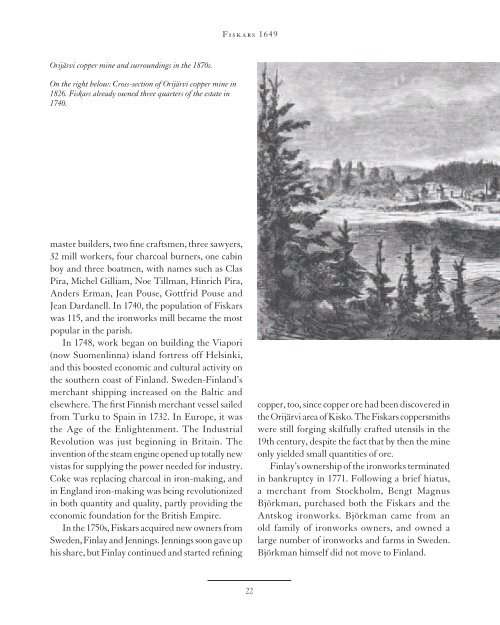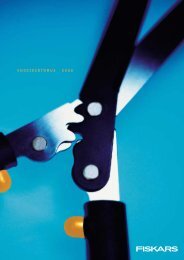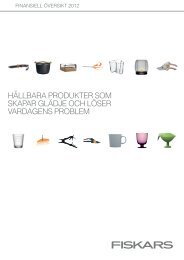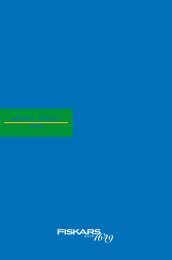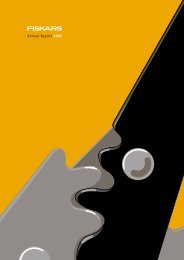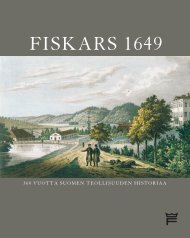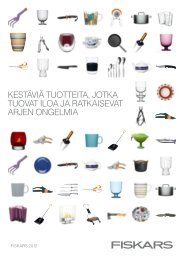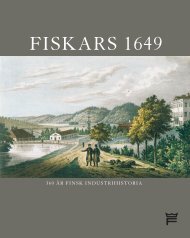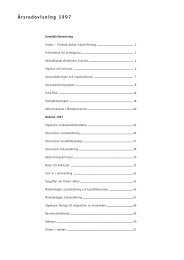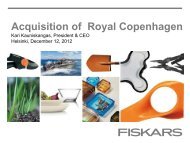FISKARS 1649 â 360 years of Finnish industrial history
FISKARS 1649 â 360 years of Finnish industrial history
FISKARS 1649 â 360 years of Finnish industrial history
You also want an ePaper? Increase the reach of your titles
YUMPU automatically turns print PDFs into web optimized ePapers that Google loves.
Fiskars <strong>1649</strong><br />
Fiskars <strong>1649</strong><br />
Orijärvi copper mine and surroundings in the 1870s.<br />
On the right below: Cross-section <strong>of</strong> Orijärvi copper mine in<br />
1826. Fiskars already owned three quarters <strong>of</strong> the estate in<br />
1740.<br />
master builders, two fine craftsmen, three sawyers,<br />
32 mill workers, four charcoal burners, one cabin<br />
boy and three boatmen, with names such as Clas<br />
Pira, Michel Gilliam, Noe Tillman, Hinrich Pira,<br />
Anders Erman, Jean Pouse, Gottfrid Pouse and<br />
Jean Dardanell. In 1740, the population <strong>of</strong> Fiskars<br />
was 115, and the ironworks mill became the most<br />
popular in the parish.<br />
In 1748, work began on building the Viapori<br />
(now Suomenlinna) island fortress <strong>of</strong>f Helsinki,<br />
and this boosted economic and cultural activity on<br />
the southern coast <strong>of</strong> Finland. Sweden-Finland’s<br />
merchant shipping increased on the Baltic and<br />
elsewhere. The first <strong>Finnish</strong> merchant vessel sailed<br />
from Turku to Spain in 1732. In Europe, it was<br />
the Age <strong>of</strong> the Enlightenment. The Industrial<br />
Revolution was just beginning in Britain. The<br />
invention <strong>of</strong> the steam engine opened up totally new<br />
vistas for supplying the power needed for industry.<br />
Coke was replacing charcoal in iron-making, and<br />
in England iron-making was being revolutionized<br />
in both quantity and quality, partly providing the<br />
economic foundation for the British Empire.<br />
In the 1750s, Fiskars acquired new owners from<br />
Sweden, Finlay and Jennings. Jennings soon gave up<br />
his share, but Finlay continued and started refining<br />
copper, too, since copper ore had been discovered in<br />
the Orijärvi area <strong>of</strong> Kisko. The Fiskars coppersmiths<br />
were still forging skilfully crafted utensils in the<br />
19th century, despite the fact that by then the mine<br />
only yielded small quantities <strong>of</strong> ore.<br />
Finlay’s ownership <strong>of</strong> the ironworks terminated<br />
in bankruptcy in 1771. Following a brief hiatus,<br />
a merchant from Stockholm, Bengt Magnus<br />
Björkman, purchased both the Fiskars and the<br />
Antskog ironworks. Björkman came from an<br />
old family <strong>of</strong> ironworks owners, and owned a<br />
large number <strong>of</strong> ironworks and farms in Sweden.<br />
Björkman himself did not move to Finland.<br />
22<br />
23


